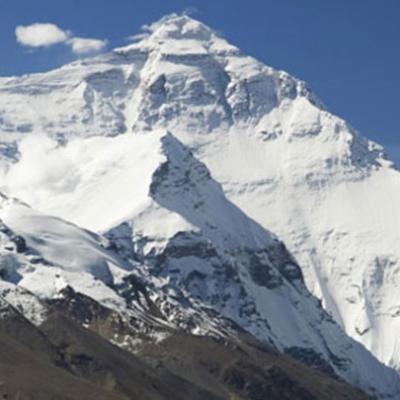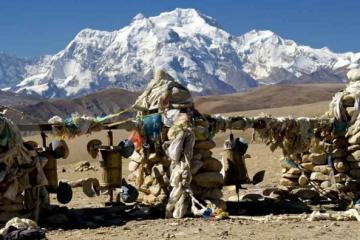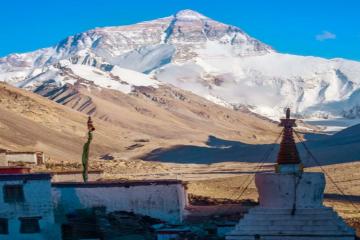Tibet
Towards the north of the mighty Himalayan Range within the administration of the Democratic People’s Republic of China lies Tibet, the roof of the world. The Tibet Autonomous Region is the second-largest province-level entity of China in terms of land, spanning approximately 1,200,000 km2 (4660,000 sq mi) in the total territory. The existing borders of the Tibet Autonomous Region were mainly set in the 18th century. These borders encompass approximately half of traditional Tibet, often known as the Tibet that retains its ethnocultural identity. There are little more than 3.6 million people living there, but the population density is only 3 people per square kilometer (7.8 people per square mi) as a direct result of the rough and steep terrain. Due to the area being the highest plateau on Earth, it is referred to as the roof of the world. It is surrounded by the Central China Plain to the north and east, Kashmir to the west, and Nepal, India, and Bhutan to the south. Most of Tibet is on top of a piece of land called the Tibetan Plateau, which is made up of the Himalayas and many of the world's highest mountains.
Although there is evidence of human habitation on the Tibetan plateau dating back to prehistoric times, the vast majority of Tibet's history was not documented until the establishment of Tibetan Buddhism in the sixth century. After Tibet's incorporation into China in 1951, many parts of the country became accessible to the outside world for the first time. During the annexation, Tibetan refugees brought their culture and identity with them to the countries they fled to escape the Chinese government.
Ever since the middle of the 17th century, Lhasa has served as both the ecclesiastical and administrative center of Tibet. It is home to a number of Buddhist sites that hold great cultural meaning for Tibetans, including the Potala Palace, Jokhang Temple, and Norbulingka Palaces. It is the location of a variety of Buddhist sites that retain a significant deal of cultural significance for Tibetans. These sites include the Norbulingka Palaces, the Potala Palace, and the Jokhang Temple. The Potala Palace was the residence of the Dalai Lama, who was the de facto head of the spiritual and political activities in Tibet since the 14th century. Avalokiteshvara, the bodhisattva of compassion, is believed to have a special relationship with the people of Tibet and to intervene in their fate by incarnating as benevolent rulers and teachers such as the Dalai Lamas in the Buddhist countries of Central Asia. This belief has been prevalent for the past millennium and is still held by a large number of people today. Tenzin Gyatso is the 14th and current Dalai Lama who lives as a refugee in India.
There are four main schools of Tibetan Buddhism: Nyingma (around the year 800), Kagyu (around the year 1100), Sakya (1073), and Gelug (1409). Before Buddhism was brought to Tibet, Bon was the most popular spiritual practice. Tibetan Buddhism has had a big impact on Bon (particularly the Nyingma school). Bodhisattvas like Avalokiteshvara, Manjushri, Vajrapani, and Tara are very important in Tibetan Buddhism. The five Buddhas of the Vajradhatu mandala and the Adi Buddha, also called Vajradhara or Samantabhadra, are the most important Buddhas. A mandala is a set of symbols in a geometric shape. In different spiritual traditions, mandalas can be used to help practitioners and adepts focus their attention, as a tool for spiritual guidance, to create a sacred space, and to help with meditation and getting into a trance. Tibetan traditions are famous for their esoteric usage of mandalas and various meditative practices.
Tibet's architecture is influenced by both China and India, but it also has many unique features that come from how it has changed to fit the cold, dry, high-altitude climate of the Tibetan plateau. Most buildings are made from materials that can be found nearby, and they are often decorated with Buddhist symbols. As an example, Buddhist prayer flags are often flown from the roofs of private homes.
Taking a trip to Tibet will be like going on the adventure of a lifetime because it will allow you to explore and experience the awesome Tibetan culture, brown rolling hills, wrecked forts, artistic ornate monasteries, centuries-old caravan trails, and breathtaking scenery of central Himalayan range of Nepal & Tibet along with the most dramatic views of Mount Everest with its Kangshung Face looks. When traveling across Tibet, you will have many thrilling and unforgettable experiences along the route, many of which you will not be able to adequately describe or understand unless you are actually there.
Best time to visit Tibet
Tibet is located on a plateau at a very high elevation, and a large portion of the country is permanently frozen throughout the year. However, the best time to visit the majority of the country is between the months of April and November. In spite of the elevation, these months have a remarkable amount of warmth, with temperatures reaching as high as 23 degrees Celsius in the month of June.
Between the months of May and October, when temperatures reach the double digits and the majority of the ice in Tibet has melted, Tibet is at its most beautiful and ideal time for tourists to visit. In addition, the months of March and April are ideal for going hiking in Tibet. During these months, you may view the most beautiful landscape in such sunny and warm weather, regardless of whether you wish to take a holy Kailash kora or just a leisurely walk around Ganden Monastery near Lhasa.
Between the months of December and March, the temperature drops below freezing and it snows frequently. This can prevent flights from entering Tibet, which makes a significant portion of Tibet's mountainous geography inaccessible, despite its gorgeous appearance.
Why Tibet with Accessible Adventure?
Accessible Adventure is a travel and tour company that is run and managed by a professional team of veteran native staff from Nepal. These staff members have extensive experience organizing and managing vacation destinations in Tibet as well as across the Himalayan bordering countries of Nepal and Bhutan.
We are a leading and rising travel company based in Kathmandu, Nepal, with more than a decade of experience operating successful trips with one-of-a-kind quality services at affordable prices. During your time with us, you will be able to take full delight in all of the Himalayan holiday destinations that we offer.
Every one of our vacations is expertly planned and organized, and we consistently receive glowing reviews from both our former and current customers and clients. They express complete contentment and gratitude for the value they receive in the vacations we provide.
When you book your trip through Accessible Adventure, you also get:
- Best Price Promised for Trip
- Guides with great emergency training at high altitude
- Ethical tourism is when bookings help the people who live there.


